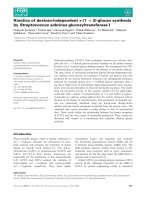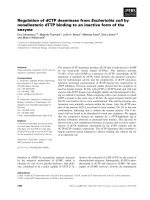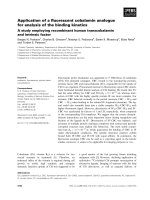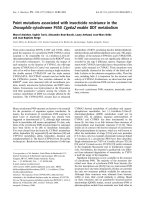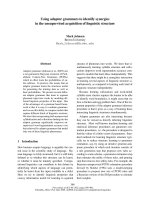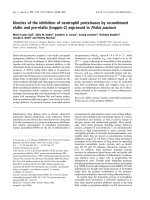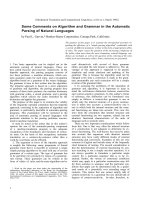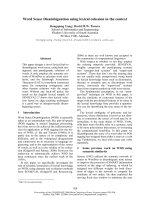Báo cáo khoa học: Kinetics of enzyme acylation and deacylation in the penicillin acylase-catalyzed synthesis of b-lactam antibiotics pptx
Bạn đang xem bản rút gọn của tài liệu. Xem và tải ngay bản đầy đủ của tài liệu tại đây (332.84 KB, 9 trang )
Kinetics of enzyme acylation and deacylation in the penicillin
acylase-catalyzed synthesis of b-lactam antibiotics
Wynand B. L. Alkema, Erik de Vries, Rene
´
Floris and Dick B. Janssen
Department of Biochemistry, Groningen Biomolecular Sciences and Biotechnology Institute, University of Groningen,
the Netherlands
Penicillin acylase catalyses the hydrolysis and synthesis of
semisynthetic b-lactam antibiotics via formation of a cova-
lent acyl-enzyme intermediate. The kinetic and mechanistic
aspects of these reactions were studied. Stopped-flow
experiments with the penicillin and ampicillin analogues
2-nitro-5-phenylacetoxy-benzoic acid (NIPAOB) and
D
-2-nitro-5-[(phenylglycyl)amino]-benzoic acid (NIPGB)
showed that the rate-limiting step in the conversion of
penicillin G and ampicillin is the formation of the acyl-
enzyme. The phenylacetyl- and phenylglycyl-enzymes are
hydrolysed with rate constants of at least 1000 s
)1
and
75 s
)1
, respectively. A normal solvent deuterium kinetic
isotope effect (KIE) of 2 on the hydrolysis of 2-nitro-5-
[(phenylacetyl)amino]-benzoic acid (NIPAB), NIPGB and
NIPAOB indicated that the formation of the acyl-enzyme
proceeds via a general acid–base mechanism. In agreement
with such a mechanism, the proton inventory of the k
cat
for
NIPAB showed that one proton, with a fractionation factor
of 0.5, is transferred in the transition state of the rate-limiting
step. The overall KIE of 2 for the k
cat
of NIPAOB resulted
from an inverse isotope effect at low concentrations of D
2
O,
which is overridden by a large normal isotope effect at large
molar fractions of D
2
O. Rate measurements in the presence
of glycerol indicated that the inverse isotope effect originated
from the higher viscosity of D
2
O compared to H
2
O.
Deacylation of the acyl-enzyme was studied by nucleophile
competition and inhibition experiments. The b-lactam com-
pound 7-aminodesacetoxycephalosporanic acid (7-ADCA)
was a better nucleophile than 6-aminopenicillanic acid,
caused by a higher affinity of the enzyme for 7-ADCA and
complete suppression of hydrolysis of the acyl-enzyme upon
binding of 7-ADCA. By combining the results of the steady-
state, presteady state and nucleophile binding experiments,
values for the relevant kinetic constants for the synthesis and
hydrolysis of b-lactam antibiotics were obtained.
Keywords: penicillin acylase; antibiotic synthesis; kinetic
mechanism; kinetic isotope effect.
Penicillin acylase (PA) (EC 3.5.1.11) of Escherichia coli
ATCC 11105 hydrolyses penicillin G to produce phenyl-
acetic acid and 6-aminopenicillanic acid (6-APA). The latter
compound can be used industrially as a precursor for the
synthesis of semisynthetic b-lactam antibiotics. In synthetic
reactions, 6-APA is coupled to an acyl group in a kinetically
controlled conversion in which the acyl group is supplied as
an activated precursor, e.g. an ester or an amide [1]. This
condensation reaction can also be catalysed by PA and the
yield of the desired product is strongly dependent on the
mechanism and kinetic properties of the catalyst [2].
The catalytic mechanism of PA involves nucleophilic
attack of the active-site serine, bS1, on the carbonyl carbon
of the amide or ester bond of the substrate [3] (residues are
labelled to indicate the subunit (a or b) and their position in
the subunit). Via a tetrahedral intermediate that is stabilized
by hydrogen bonds between the oxyanion hole residues
bN241 and bA69 and the negatively charged oxygen of
the substrate, an acyl-enzyme is formed concomitant with
expulsion of the leaving group [3–5]. The acyl-enzyme may
be deacylated by H
2
O, yielding the hydrolysis product and
thefreeenzyme.Inthismechanism,thefreeN-terminal
NH
2
group of the catalytic serine functions as the catalytic
base, activating the nucleophile by proton abstraction in the
acylation reaction. In the presence of a b-lactam nucleo-
phile, such as 6-APA or 7-aminodesacetoxycephalosporanic
acid (7-ADCA), the acyl group may be transferred to the
b-lactam moiety rather than to H
2
O, producing a semisyn-
thetic antibiotic.
The kinetic scheme for PA-catalysed acyl transfer to H
2
O
or a b-lactam nucleophile can be described by the scheme
developed for hydrolysis and synthesis of peptides by
chymotrypsin and papain (Fig. 1) [2,6,7].
Assuming rapid binding, and applying a steady
state assumption for EAc and EacN, gives the following
Correspondence to D. B. Janssen, Department of Biochemistry,
Groningen Biomolecular Sciences and Biotechnology Institute,
University of Groningen, Nijenborgh 4, 9747 AG Groningen,
the Netherlands. Fax: + 31 50 3634165, Tel.: + 31 50 3634209,
E-mail:
Abbreviations: PA, penicillin acylase; PAPNA, phenylacetyl-p-nitro-
anilide; NIPAB, 2-nitro-5-[(phenylacetyl)amino]-benzoic acid;
NIPGB,
D
-2-nitro-5-[(phenylglycyl)amino]-benzoic acid; 6-APA,
6-aminopenicillanic acid; 7-ADCA, 7-aminodesacetoxycephalospo-
ranic acid; PGA,
D
-phenylglycinamide; PAA, phenylacetic acid amide;
NIPAOB, 2-nitro-5-phenylacetoxy-benzoic acid; PNA,
p-nitrophenylacetate; PGPNA,
D
-phenylglycine-p-nitroanilide;
pNPA, p-nitrophenylacetate; KIE, kinetic isotope effect.
Enzymes: penicillin acylase (PA; EC 3.5.1.11).
(Received 3 April 2003, revised 13 June 2003, accepted 26 June 2003)
Eur. J. Biochem. 270, 3675–3683 (2003) Ó FEBS 2003 doi:10.1046/j.1432-1033.2003.03728.x
expression for yield of the desired product, i.e. the maximum
product accumulation [Q]
max
[8]:
[Q]
max
¼
K
Q
k
hQ
Á
k
2
K
AD
Á
[N]Ák
s
k
h1
ÁK
EAcN
þ k
h2
Á½N
Á½ADð1Þ
In this equation [AD] and [N] are the concentrations of
acyl donor and nucleophile, respectively, at the point
where [Q]
max
is reached.
Equation (1) shows that the kinetic constants for the
acylation by the substrate AD or the product Q and the
competition for the acyl-enzyme between H
2
O and a second
nucleophile N are important factors with respect to the
formation of transacylation products. Although several
studies have appeared that have addressed the kinetic
properties of the enzyme and mutants [4,9–13], investiga-
tions into the individual rate and binding constants
underlying the kinetic properties and biocatalytic perform-
ance in the synthesis and hydrolysis of antibiotics are scarce
[11,14,15].
We attempted to determine the kinetic constants of PA,
which are relevant for the hydrolytic and the synthetic
reactions, to obtain more insight into the interactions in the
active site that influence synthetic performance. Using
stopped-flow experiments and nucleophile binding studies
we were able to obtain values for the kinetic constants for
hydrolysis and synthesis of penicillin G, ampicillin and
cephalexin. Furthermore, insight into the nature of the
transition state in the rate-determining steps of the reaction
was obtained by analysing solvent kinetic isotope effects.
Materials and methods
Kinetic measurements
All kinetic experiments were done with purified penicillin
acylase of E. coli ATCC 11105, which was obtained as
described previously [4]. The enzyme concentration was
determined by measuring A
280
and using e ¼
210 000
M
)1
Æcm
)1
. The conversion of the chromogenic
substrates 2-nitro-5-[(phenylacetyl)amino]-benzoic acid
(NIPAB) (De
405nm
¼ 9.09 m
M
)1
.cm
)1
), phenylacetyl-p-
nitroanilide (PAPNA) (De
405nm
¼ 13 m
M
)1
Æcm
)1
), 2-nitro-
5-phenylacetoxy-benzoic acid (NIPAOB) (De
405nm
¼
11.4 m
M
)1
Æcm
)1
),
D
-2-nitro-5-[(phenylglycyl)amino]-ben-
zoic acid (NIPGB) (De
405nm
¼ 9.09 m
M
)1
Æcm
)1
),
D
-phenyl-
glycine-p-nitroanilide (PGPNA) and p-nitrophenylacetate
(p-NPA) (De
405nm
¼ 13 m
M
)1
Æcm
)1
) was followed by meas-
uring the increase in absorbance change at 405 nm, on a
Perkin Elmer Bio40 UV/VIS spectrophotometer at 30 °Cin
50m
M
phosphate buffer, pH 7.0. The stopped-flow experi-
ments were carried out on an Applied Photophysics
SX.17MV spectrophotometer, with a 10-mm optical path
length. The stopped-flow cell was thermostatically con-
trolled at 30 °C. Stock solutions of all ester substrates were
made in acetonitrile and diluted to the appropriate concen-
tration in 0.5% acetonitrile in 50 m
M
phosphate buffer,
pH 7.0, prior to the start of kinetic experiments. Conversion
of non chromogenic substrates was followed using HPLC as
described [4]. Nucleophile competition experiments were
carried out by mixing enzyme with solutions of acyl donor
and nucleophile. The enzymatic conversions were followed
by HPLC and the V
s
/V
h
ratios were calculated from the
initial rates of the formation of synthesis and hydrolysis
products.
Buffers for experiments in D
2
O were prepared as follows:
solutions of 50 m
M
KH
2
PO
4
and K
2
HPO
4
Æ3H
2
Owere
made by dissolving the appropriate amount of salt in D
2
O.
Both solutions were combined to yield a buffer solution with
apHmeterreadingof6.6.H
2
O/D
2
Omixturesweremadeby
mixing 50 m
M
potassium phosphate buffers in D
2
O, pH 6.6
with 50 m
M
potassium phosphate buffers in H
2
O, pH 7.0.
The values for De were corrected for the influence of D
2
Oon
the extinction coefficients, which was measured with all
H
2
O/D
2
O mixtures that were used. Proton inventories were
carried out at pL 7.0, which is in the pH-independent region
for PA catalysed hydrolysis reactions [9].
Fitting of kinetic parameters to the data was done using
the program
SCIENTIST
(Micromath Inc., version 2.0). The
goodness of fit and the information content of the data were
checked by inspecting the value for the model selection
criterion, standard deviations for the 95% confidence
interval of the parameter values and the correlation matrix
for the fitted parameters [16]. These parameters were
calculated using the Statistics procedure implemented in
the
SCIENTIST
program.
Chemicals
NIPAB, p-NPA, phenylacetic methyl ester and phenylacetic
acid ethyl ester were purchased from Sigma Chemical
Company. NIPAOB, NIPGB and 5-(2-amino-2-phenyl-
acetoxy)-2-nitro-benzoic acid (NIPGBester) were purchased
from Syncom (Groningen, the Netherlands). PGPNA,
ampicillin, penicillin G, 6-APA and 7-ADCA were obtained
from DSM-Gist (Delft, the Netherlands). PAPNA was
prepared as follows: phenylacetylchloride was added drop-
wise to an equimolar amount of 4-nitroaniline dissolved in
chloroform containing one equivalent of triethyl amine.
After refluxing for 3 h, the mixture was extracted with 1
M
Fig. 1. Kinetic scheme describing the synthesis and hydrolysis reactions
catalysed by penicillin acylase, adapted from a similar scheme for
chymotrypsin catalysed reactions [7]. In this Scheme A(D) is the acyl
donor, N the b-lactam nucleophile, Q the product of aminolysis (i.e.
the antibiotic) and A the product of hydrolysis (i.e. the acid of the acyl
donor). EAD, EN, and EQ are the enzymes with substrates nonco-
valently bound, whereas EAc and EAcN represent the acyl-enzyme
intermediate with and without bound nucleophile. The rate constants
for the acylation of the enzyme are given by k
2
, k
2N
and k
hQ
,whereas
k
s
, k
h1
and k
h2
are the rate constants for deacylation. K
Q
, K
AD
and K
N
,
K
EAcN
are the binding constants of the substrates to the free enzyme
and the acyl-enzyme, respectively.
3676 W. B. L. Alkema et al.(Eur. J. Biochem. 270) Ó FEBS 2003
HCl and 1
M
NaOH. After drying and evaporation a white-
yellow solid was obtained that was recrystallised from
methanol/ether. Mp. 114–115 °C (uncorr.).
1
HNMR
(300 MHz, dimethylsulfoxide d6) d (p.p.m.): 3.71 (s, 2H,
CH
2
); 7.26–7.35 (m, 5H, CH); 7.82 (d, J ¼ 9.0 Hz, 2H,
CH); 8.20 (d, J ¼ 9.0, 2H, CH); 10.77 (brs, 1H, NH).
Phenylacetamide was prepared as follows: phenylacetyl-
chloride was added dropwise to concentrated ammonia
solution. This gave the product as a white precipitate that
was filtered off and dried to constant weight. Mp. 152–
153 °C (uncorr.).
1
H NMR (300 MHz, D
2
O) d (p.p.m.):
3.65 (s, 2H, CH
2
); 7.35–7.50 (m, 5H, CH).
Results and Discussion
Steady-state kinetic parameters for phenylacetylated
and phenylglycylated substrates
The hydrolysis of acyl donors and antibiotics by PA
proceeds via a two step mechanism, involving acylation of
the active-site serine by the substrate and subsequent
hydrolysis of the acyl-enzyme. In the absence of a nucleo-
phile other than water, the steady-state rate of production of
[A] by hydrolysis of the substrate [AD], according to
Scheme 1, is given by [17]:
d½A
dt
¼
k
cat
ÁE
0
Á[AD]
K
m
þ [AD]
ð2Þ
in which
k
cat
¼
k
2
Ák
h1
k
2
þ k
h1
ð3Þ
and
K
m
¼
K
AD
Ák
h1
k
2
þ k
h1
ð4Þ
If deacylation of the enzyme is much slower than
acylation, i.e. k
h1
( k
2
, the k
cat
is given by k
h1
and burst
kinetics for the release of the first product P will be
observed [17]. If, however, only acylation of the enzyme
is rate-limiting, i.e. k
2
( k
h1
, the value for k
cat
is given
by k
2
and an effect of the leaving group of the substrate
on the k
cat
can be observed.
To investigate whether acylation or deacylation is the
rate-limiting step in the conversion of phenylacetylated and
phenylglycylated substrates, we determined the steady-state
kinetic parameters for a series of amides and esters, with
phenylglycine or phenylacetic acid as the acyl group and
different leaving groups (Table 1) (Fig. 2).
For the hydrolysis of amides of phenylacetic acid,
different k
cat
values were observed for substrates with
different leaving groups. The k
cat
values for the methyl and
ethyl ester of phenylacetic acid were approximately fivefold
higher than for the best amide substrate, phenylacetamide,
which is in agreement with the fact that amide bonds are in
general more stable than ester bonds. The k
cat
/K
m
for
NIPAOB was more than threefold higher than for penicillin
G, which makes NIPAOB the best substrate known so far
for penicillin acylase. The k
cat
values for phenylacetic acid
methyl ester and phenylacetic acid ethyl ester were only
slightly lower than the k
cat
of NIPAOB, indicating that
increasing the reactivity of the carbonyl function of the
substrate by using p-hydroxynitrobenzoic acid as the leaving
group, did not lead to a higher rate of conversion. For esters
of phenylglycine the k
cat
was similar to the k
cat
for
phenylglycine amide, indicating that the higher reactivity
of the ester bond also did not lead to an increased rate of
conversion.
These results indicate that for hydrolysis of the phenyl-
acetylated amides, the rate-limiting step is the formation of
the acyl-enzyme and k
cat
is given by k
2
. For esters of
phenylacetic acid and esters or amides of phenylglycine, in
which a leaving group effect was almost absent, the k
cat
may
be set by k
2
, k
h1
or a combination of k
2
and k
h1
.
If k
2
and k
h1
are in the same order of magnitude a
presteady-state burst of product formation should be
observed from which the values for k
2
and k
h1
can be
calculated [18,19]. To obtain the values for k
2
and k
h1
,we
performed stopped-flow experiments with the chromogenic
Table 1. Steady-state parameters of penicillin acylase for the hydrolysis
of esters and amides of phenylacetic acid and phenylglycine. The struc-
tures of the chromogenic substrates are shown in Fig. 2. The reaction
conditions are given in the Materials and methods section. Values
represent means of three experiments. The standard deviation was in
all cases within 10% of the mean values.
Substrate
k
cat
(s
)1
)
K
m
(m
M
)
k
cat
/K
m
(m
M
Æs
)1
)
Amides
NIPAB 15 0.015 1000
PAPNA 14 0.13 107
Phenylacetamide 50 0.180 277
Penicillin G 42 0.007 6000
NIPGB 15 1.7 8.82
PGPNA 3.1 1.7 1.82
Phenylglycine amide 30 40 0.75
Ampicillin 30 2.5 12
p-NPA 1 0.029 34
Esters
NIPAOB (NIPABester) 200 0.011 18181
Phenylacetic acid methyl ester 190 0.16 1187
Phenylacetic acid ethyl ester 170 0.11 1545
NIPGBester –
a
–
Phenylglycine methyl ester 50 12.5 4
Phenylglycine ethyl ester 24 12 2
a
Chemically unstable.
Fig. 2. Structures of the chromogenic substrates used in this study.
NIPGBester was hydrolysed by penicillin acylase, but due to high rates
of solvolysis, no kinetic parameters could be determined.
Ó FEBS 2003 Kinetic analysis of penicillin acylase (Eur. J. Biochem. 270) 3677
substrates NIPAOB and NIPGB. No initial burst of
product formation was observed during the hydrolysis of
both compounds, indicating that the acylation rate is much
slower than the rate of deacylation. The theoretical maxi-
mum of the amplitude of the burst phase is equal to the total
enzyme concentration. When k
h1
¼ 5 k
2
, only 2% of the
maximum of the amplitude of the burst phase can be
observed which is considered to be the lower limit of
detection. Since the k
cat
for the hydrolysis of NIPAOB is
200 s
)1
, hydrolysis of the acyl-enzyme must take place at a
rate of at least 1000 s
)1
. Likewise, the lower limit for the
hydrolysis of the phenylglycylated enzyme is at least 75 s
)1
,
which is 5 k
cat
for the hydrolysis of NIPGB. Attempts to
obtain a more accurate estimate for the lower limit of k
h1
,by
using the more reactive ester of NIPGB in kinetic experi-
ments, failed because of the high rates of spontaneous
hydrolysis of this compound.
The only substrate of PA for which the steady-state rate
of hydrolysis was preceded by an exponential burst phase
was p-NPA, indicating that for this substrate the rate of
formation of the covalent intermediate is faster than the
hydrolysis rate, in agreement with results obtained by
Morillas et al. (1999) (Fig. 3).
These results indicate that in the hydrolysis of acyl donors
and antibiotics the breakdown of the acyl-enzyme is much
faster than the rate of formation of the acyl-enzyme. It
follows from Eqns (3 and 4) that under these conditions the
K
m
is equal to the dissociation constant of the substrate,
K
AD
or K
Q
,andthatthek
cat
for hydrolysis equals the rate
constant for acylation.
Proton transfer in the acylation reaction
To obtain further information about the rate-limiting
reactions, we determined the solvent deuterium kinetic
isotope effect (KIE) on these reactions. The k
cat
for the
hydrolysis of NIPAB, NIPGB and NIPAOB all displayed a
normal solvent deuterium KIE of 2, whereas no effect of
D
2
OontheK
m
was observed. For the substrates NIPAB
and NIPAOB, a proton inventory was recorded by
measuring the k
cat
in mixtures of H
2
OandD
2
O (Fig. 4).
The relation between the value of a rate constant and the
mole fraction D
2
O can be described by the simplified form
of the Gross–Butler equation [20],
k
x
k
0
¼
Y
v
i
ð1 À x þ x/
T
i
Þð5Þ
In this equation k
x
is the rate constant at D
2
O fraction x,
k
0
the rate in H
2
O, U
T
i
the transition state fractionation
factor at the i
th
exchangeable hydrogenic site, and v the
number of protons involved in the reaction [20]. If one
proton is in flight in the transition state, a plot of k
x
/k
0
vs. x gives a straight line, whereas a second or multiple
order polynomial is indicative of more than one proton
being transferred in the transition state.
A linear dependence of k
x
/k
0
on x was observed for the
k
cat
for NIPAB, suggesting that one proton is transferred in
the transition state of the reaction. Fitting to the Gross–
Butler equation yielded a fractionation factor of 0.5 for the
proton that is exchanged. This fractionation factor is
indicative of general acid/base catalysis mechanism where
the proton is less tightly bound in the transition state than in
the reactant state [21], in agreement with the mechanism of
PA-catalysed hydrolysis as proposed by Duggleby et al.
(1995). The proton that gives rise to the normal isotope
effect may be the proton that is transferred from the seryl
oxygen to the seryl amino group during activation of the
nucelophilic serine, or the proton that is donated to the
leaving group during collapse of the tetrahedral intermediate.
Fig. 3. Stopped-flow traces using NIPGB, NIPAOB and p-NPA. For
NIPGB and NIPAOB, the final enzyme concentration was 4 l
M
and
substrate concentration was 10ÆK
m
. For p-NPA the final enzyme
concentration was 3 l
M
and substrate concentration was 400 l
M
.
Fig. 4. Effect of D
2
O and glycerol on the hydrolysis of NIPAB and NIPAOB. (A) Proton inventories for k
cat
of NIPAB and NIPAOB. k
cat
values
were determined at a substrate concentration of 1 m
M
, which is 100-fold higher than the K
m
for these substrates at varying molar fractions of D
2
O
(·). m,NIPAB;j, NIPAOB. The symbols and standard deviations represent the mean of three independent experiments. The lines are the best fit
to the data using Eqn (5) (NIPAB) and Eqn (6) (NIPAOB). (B) The figure shows k
cat
values for NIPAB (m) and NIPAOB (j) in phosphate buffer
with increasing concentrations of glycerol.
3678 W. B. L. Alkema et al.(Eur. J. Biochem. 270) Ó FEBS 2003
A concerted mechanism in which the proton would be
directly transferred from the seryl oxygen to the leaving
group, mediated by the hydrogen bonding with the seryl
NH
2
group but without protonation of this group, may also
cause a linear proton inventory.
For the hydrolysis of NIPAOB a different effect of D
2
O
was found. We observed an increase of k
cat
at small mole
fractions of D
2
O, whereas there was an almost linear
decrease of the k
cat
at larger mole fractions of D
2
O. Unlike
with NIPAB, these data could not be fitted to Eqn (5), or to
a modified Gross–Butler equation taking medium effects
into account [22]. The higher viscosity of D
2
O compared to
H
2
O and the isotope effects on H-bonds have been described
to influence the enzyme structure, flexibility and stability
[23–27]. D
2
O effects on rate constants that result from
changes in solvent viscosity instead of proton transfer in the
rate-limiting step have been described for chymotrypsin,
NAD-malic enzyme and alkaline phosphatase [28–30]. It is
conceivable that the increase in activity of PA may be caused
by small structural changes in the active site at low
concentrations of D
2
O, making enzyme–substrate inter-
actions more favourable for catalysis than in H
2
O.
To study the influence of solvent viscosity on the
hydrolysis of NIPAB and NIPAOB, the k
cat
values for
these substrates at various glycerol concentrations were
determined (Fig. 4). It appeared that the k
cat
for NIPAOB
increased to a maximum of 105% at 9% glycerol whereas
the k
cat
for NIPAB decreased with increasing concentrations
of glycerol. To account for viscosity effects on enzyme
activity, Eqn (6) was fitted to the data. In this equation a
term is included that describes the rate enhancement
originating from solvent properties. It is assumed that the
rate enhancement with NIPAOB as the substrate due to the
presence of D
2
O is maximal at a certain mole fraction of
D
2
O, given by k¢,whereK
x
isthemolefractionofD
2
Oat
which half of the maximal rate enhancement is obtained.
k
x
k
0
¼
K
x
þ k
0
Áx
K
x
þ x
Á
Y
v
i
ð1 À x À x/
T
i
Þð6Þ
The second term is the simplified form of the Gross-
Butler equation and describes the decrease in rate due to
proton transfer in the transition state. Fitting Eqn (6) to
these data yielded values of 1.58 ± 0.03 for k¢ and
0.0078 ± 0.0016 for K
x
. The best fit was obtained
assuming a two-proton transfer mechanism, suggesting
that two protons are transferred in the transition state of
this reaction. However, a distinction between a one-
proton and a multiple-proton mechanism can only be
made when more accurate data can be obtained since it
requires precise measurement of small differences in
curvature of the proton inventory. Given the influence
of the viscosity and the additional measurements that
were carried out to account for background hydrolysis
and the influence of D
2
O on the extinction coefficient of
the hydrolysis product, more accurate data are needed
to draw definitive conclusions about the number of
protons being transferred in the transition state of
NIPAOB hydrolysis.
The results of the proton inventories indicate that the
mechanisms for the conversion of the substrates that were
studied, differ significantly from each other. Substrate-
dependent proton inventories have also been observed for
the serine proteases elastase [31] and chymotrypsin [32]. The
results of the proton inventories for NIPAB and NIPAOB
suggest that also in PA-catalysed reactions the structure of
the leaving group of the substrate has an effect on the details
of the kinetic mechanism.
Deacylation by b-lactam nucleophiles
Since the rate-limiting step for the hydrolysis of phenyl-
acetylated and phenylglycylated substrates is the acylation
step, kinetic effects such as solvent KIEs on the steady-state
parameters can be attributed to effects on events in the
acylation step. For the deacylation such information is more
difficult to obtain since the individual rate and binding
constants cannot be measured separately. Some information
may be obtained by performing nucleophile competition
experiments [7]. The rate of aminolysis vs. hydrolysis can be
expressed as the V
s
/V
h
ratio and according to Scheme 1, is
given by [33]:
V
s
V
h
¼
[N]Ák
s
k
h1
ÁK
EAcN
þ k
h2
Á½N
ð7Þ
The above kinetic experiments showed that the hydro-
lysis of the phenylacetylated enzyme (k
h1
) proceeds with
a rate of at least 1000 s
)1
. To obtain significant rates of
aminolysis at such a high rate of hydrolysis, it follows
from Eqn (7) that either the reactivity of the b-lactam
nucleophile with the acyl-enzyme (k
s
) must be consider-
ably higher than k
h1
, or tight binding of the b-lactam
nucleophile to the acyl-enzyme, giving a low value for
K
EacN
, must occur, in which case k
s
must be higher than
k
h2
. Moreover, competition for nucleophilic attack
between H
2
O and a b-lactam nucleophile may be
affected by the type of acyl-enzyme that is formed, i.e.
whether phenylacetic acid or phenylglycine is the acyl
moiety, and by the structure of the b-lactam nucleophile.
To investigate the kinetic mechanism of deacylation and
to assess the influence of the structure of the acyl donor
and nucleophilic b-lactam on this reaction, we per-
formed nucleophile competition experiments using two
different acyl donors, phenylacetamide and phenylgly-
cine amide and two different nucleophiles, 6-APA and
7-ADCA.
From Eqn (7) it follows that the relationship of V
s
/V
h
vs.
[N] is hyperbolic and may be written as
V
s
V
h
¼
V
s
V
h
max
Á½N
K
Napp
þ½N
ð8Þ
in which
V
s
V
h
max
¼
k
s
k
h2
ð9Þ
and K
Napp
, at which half of the (V
s
/V
h
)
max
is reached, is
K
Napp
¼
k
h1
k
h2
ÁK
EAcN
ð10Þ
Equation (10) shows that the apparent affinity of the
enzyme for the nucleophile (K
Napp
) is given by the
binding constant of the nucleophile to the acyl-enzyme
Ó FEBS 2003 Kinetic analysis of penicillin acylase (Eur. J. Biochem. 270) 3679
(K
EAcN
) and the ratio between the rates of hydrolysis of
the acyl-enzyme with nucleophile bound (k
h2
) and
without nucleophile bound (k
h1
). In other words, when
binding of the b-lactam nucleophile leads to a reduction
of the rate of deacylation by H
2
O by lowering the
nucleophilicity of H
2
O or by displacement of water from
the active site, the apparent affinity for the b-lactam
nucleophile decreases (K
Napp
increases) and the relation-
ship between V
s
/V
h
and [N] will approach to a straight
line, given by,
V
s
V
h
¼
k
s
k
h1
ÁK
EAcN
Á[N] ð11Þ
For the synthesis of ampicillin, using phenylglycine
amide as the acyl donor and 6-APA as the nucleophile, a
saturation of V
s
/V
h
was observed at increasing 6-APA
concentrations, indicating that when 6-APA is bound to
the acyl-enzyme, H
2
O is not excluded from the active
site and still able to deacylate the enzyme (Fig. 5A). In
contrast, a linear dependence was observed in the
concentration range of 0–250 m
M
6-APA when phenyl-
acetamide was used as the acyl donor, producing
penicillin G. Both the (V
s
/V
h
)
max
and the K
Napp
for this
reaction were higher than observed for synthesis of
ampicillin.
Values of 47 ± 8 m
M
for K
Napp
and of 3.6 ± 0.22 for
(V
s
/V
h
)
max
for the synthesis of ampicillin were obtained
from fitting Eqn (8) to the data. For synthesis of penicillin
G, a value of 0.018 m
M
)1
for the slope of the curve was
obtained, but due to the almost linear dependence of V
s
/V
h
on the concentration of 6-APA no reliable values for
(V
s
/V
h
)
max
and a K
Napp
for penicillin G synthesis could be
obtained.
These results show that the competition between H
2
O
and 6-APA for the acyl-enzyme is strongly dependent on the
type of acyl group and that binding of 6-APA to the
phenylacetylated enzyme suppresses hydrolysis more than
binding of 6-APA to the phenylglycylated enzyme.
When 7-ADCA was used as the deacylating nucleophile
instead of 6-APA and phenylglycine amide as the acyl
donor, a higher V
s
/V
h
was observed at all concentrations of
7-ADCA. The dependence of V
s
/V
h
on [7-ADCA] was
linear, with a value of 0.33 m
M
)1
for the slope, in contrast to
the saturation at a lower V
s
/V
h
value that was found with
6-APA as the nucleophile, indicating that the enzyme has a
lower apparent affinity for 7-ADCA (Fig. 5B).
Yousko et al. (2002) found similar constants for the
V
s
/V
h
for deacylation with 7-ADCA and 6-APA using PAA
and PGA. However they observed in all cases a saturation
of the (V
s
/V
h
)
max
, whereas our data indicate a linear relation
for the combinations of 7-ADCA/PGA and 6-APA/PAA.
Since their measurements were carried out at a different
pH, this indicates that competition between water and
the nucleophilic b-lactam at the active-site may be
pH-dependent.
From Eqn (10) it follows that the higher K
Napp
for
7-ADCA may be caused by a lower affinity of the enzyme
for 7-ADCA compared to 6-APA or it could be that
binding of 7-ADCA to the acyl-enzyme lowers the k
h2
more
than binding of 6-APA. To discriminate between these two
phenomena we studied binding of 6-APA and 7-ADCA to
the enzyme by measuring the inhibition of the hydrolysis of
NIPGB. Both 6-APA (data not shown) and 7-ADCA
competitively inhibit the hydrolysis of NIPGB as indicated
by the Lineweaver-Burk plots that intersected on the y-axis
(Fig. 6).
The nucleophile with the highest reactivity, 7-ADCA, has
a K
i
of 7 m
M
whereas for 6-APA a K
i
of 50 m
M
was
measured. The values for K
i
represent binding of the
nucleophile to the free enzyme and were used as an
estimation for the K
EacN
, which represents binding of the
nucleophile to the acyl-enzyme. Substituting the values of K
i
Fig. 5. Nucleophile competition experiments with penicillin acylase.
(A) Dependence of V
s
/V
h
on [6-APA], using phenylacetamide (PAA)
or phenylglycine amide (PGA) as the acyl donor. (B) Dependence of
V
s
/V
h
on [N], using 7-ADCA or 6-APA as the nucleophiles and
phenylglycine amide as the acyl donor. (C) Dependence of V
s
/V
h
on
[APA], using phenylacetamide as the acyl donor in H
2
O and 100%
D
2
O. The symbols represent experimental data, the lines are the best fit
to the data using Eqn (8).
3680 W. B. L. Alkema et al.(Eur. J. Biochem. 270) Ó FEBS 2003
for K
EAcN
in Eqn (10) revealed that the reduced apparent
affinity for 7-ADCA is not caused by weaker binding of
7-ADCA but by a lower k
h2
, which represents hydrolysis of
the acyl-enzyme to which 7-ADCA is bound. The increased
slope of the curve of V
s
/V
h
vs. [N] obtained for 7-ADCA
can be fully explained by the fivefold higher affinity of the
enzyme for 7-ADCA compared to 6-APA, which indicates
that the rate constant k
s
for 7-ADCA is equal to the k
s
for
6-APA.
The dependence of V
s
/V
h
on the nucleophile concentra-
tion [N] and the results of the inhibition studies show that,
despite of the high rate of hydrolysis of the acyl-enzyme,
tight binding of the nucleophile and displacement of the
catalytic H
2
O molecule ensure that significant deacylation
by b-lactam nucleophiles can occur. The results obtained
with 7-ADCA and 6-APA showed that differences in
structure of the nucleophiles far from the nucleophilic
amino function exert a large influence on the competition of
the nucleophiles with H
2
O for the acyl-enzyme. The 6-APA
moiety of penicillin G binds with the thiazolidine ring to the
enzyme via hydrophobic interactions between the 2b-methyl
group and aF146 and bF71 and hydrogen bonding between
its carboxylate group and aR145:NH
2
[4,9,34]. In 7-ADCA,
which has a dihydrothiazine ring instead of a thiazolidine
ring, the 2b-methyl group is not present and due to the more
planar character of the dihydrothiazine ring, the carboxylate
group may be in a different position than in 6-APA.
Consequently, it is conceivable that binding of 7-ADCA to
the enzyme is mediated via different interactions than
binding of 6-APA, which may explain the higher affinity of
the enzyme for 7-ADCA and the higher nucleophilicity of
7-ADCA compared to 6-APA.
Proton transfer in the deacylation reaction
To study whether proton transfer would be important in the
deacylation of phenylacetylated acyl-enzyme, we measured
the initial V
s
/V
h
in D
2
O at several concentrations of 6-APA
(Fig. 5C). The V
s
/V
h
showed an inverse isotope effect of 2.6
at all concentrations of 6-APA, indicating that aminolysis is
less sensitive to an increasing concentration of D
2
Othan
hydrolysis. A curved proton inventory for V
s
/V
h
was
observed that was best fitted with a second order poly-
nomial (Fig. 7).
The V
s
/V
h
ratio is the ratio of the reaction rates of
aminolysis and hydrolysis of the acyl-enzyme. The curva-
ture of the plot of V
s
/V
h
vs. the mole fraction of D
2
O
indicates therefore that the deuterium KIE arises from
either multiple protons being transferred in one of the
transition states of the deacylation reaction or from separate
effects of D
2
O on the transition states of both the hydrolysis
and aminolysis reaction. The latter possibility seems more
likely, in view of the one-proton transfer mechanism
suggested for deacylation of PA [3,35].
Conversion of p-NPA leads to an acyl-enzyme in which
an acetyl group is attached to the active-site serine.
Deacylation of this acetyl-enzyme is the rate-limiting step
in the catalytic cycle. No solvent KIE was observed on the
k
cat
of p-NPA suggesting that in the transition state of this
hydrolytic reaction no protons are transferred (Fig. 7). This
indicates that in this deacylation reaction a chemical
reaction involving proton transfer is not the rate-limiting
step, in contrast to deacylation of the phenylacetylated
enzyme. The rate constant for deacylation of the acetyl-
enzyme may reflect another step, such as a conformational
change of the enzyme prior to chemical hydrolysis of the
acyl-enzyme by water. A conformational change in the
deacylation of p-NPA is not unlikely in view of structural
results obtained by Done et al.[36].Inthisworkitwas
shown that p-nitrophenylacetic acid may bind in the acyl-
binding site of PA. Hydrolysis of p-NPA may thus proceed
via reversed binding of the substrate, in which the leaving
group, p-nitrophenol, occupies the acyl binding site and the
acetyl group binds at the leaving group binding site,
sterically hindering the deacylating H
2
O molecule for
efficient nucleophilic attack. A conformational change
may be necessary for release of p-nitrophenol from the
active site and subsequent deacylation of the acetyl-enzyme.
Fig. 6. Inhibition of NIPGB hydrolysis by 7-ADCA. Lineweaver–Burk
plot of the effect of various concentrations of 7-ADCA on the con-
version of NIPGB. d,0m
M
7-ADCA; .,10 m
M
7-ADCA; m,15m
M
7-ADCA; j,20m
M
7-ADCA. The lines represent linear regressions
through the data points.
Fig. 7. Proton inventories for the deacylation of phenylacetylated PA
and acetylated PA. j, Dependence of V
s
/V
h
on the molar fraction D
2
O
(·) using phenylacetamide as the acyl donor and 6-APA as the
nucleophile. The symbols represent the experimental data and the line
is the best fit to the data using Eqn (5). d, Dependence of the k
cat
for
hydrolysis of p-NPA on the molar fraction D
2
O.Forthissubstrate,
acylation is faster than deacylation and the k
cat
thus represents the rate
of breakdown of the acyl-enzyme intermediate.
Ó FEBS 2003 Kinetic analysis of penicillin acylase (Eur. J. Biochem. 270) 3681
Structural analysis of an enzyme-substrate complex could
confirm the existence of such a reversed binding mode [4,5].
Kinetic constants for PA catalyzed synthesis
and hydrolysis of b-lactam antibiotics
The kinetic properties of PA are important with respect to
the yield that can be obtained in a kinetically controlled
synthesis of b-lactam antibiotics. Combining the data from
the steady-state and presteady state experiments and the
data from nucleophile competition and inhibition experi-
ments, the kinetic constants for the synthesis and hydrolysis
of b-lactam antibiotics can be calculated (Table 2). Exact
values can be determined for the rate constants of acylation,
whereas only relative rates can be obtained for the deacy-
lation by various nucleophiles. The values for the hydrolysis
and synthesis of ampicillin are close to the numbers
obtained by Yousko and Svedas [15]. Eqn (1) shows that
for the application of the enzyme in synthesis two kinetic
properties are important. First, the enzyme should have a
low activity for the antibiotic compared to the acyl donor.
The relative specificity of the enzyme for both substrates
may be expressed by the factor a, given by [7],
a ¼
k
cat
=K
m
ðÞ
Q
k
cat
=K
m
ðÞ
AD
¼
k
hQ
=K
Q
k
2
=K
AD
ð12Þ
The data in Table 1 show that a for the synthesis of
ampicillin cannot be decreased by using the chemically
more reactive phenylglycine ester instead of phenylgly-
cine amide. The chemical reactivity of the ester bond
cannot be fully exploited by the enzyme to increase the
rate of acylation. This may be caused by the fact that the
enzyme is probably evolutionary optimized for phenyl-
acetylated rather than phenylglycylated compounds
[37,38]. Furthermore the K
m
for the product ampicillin
is much lower than the K
m
values for the acyl donors
phenylglycine amide and phenylglycine methyl ester.
Both the low activity of PA for ester substrates
compared to amides and the high affinity of the enzyme
for the product of synthesis increase a and hence reduce
the yield in synthesis reactions.
A second requirement for efficient synthesis is a high rate
of aminolysis compared to hydrolysis. The experiments with
the most important nucleophiles in b-lactam antibiotic
synthesis, 7-ADCA and 6-APA, showed that tight binding
of the nucleophile to the acyl-enzyme and displacement of
the hydrolytic water molecule are the two most important
factors in determining the reactivity of the nucleophile. The
fact that the acyl-enzyme to which 7-ADCA is bound
cannot be hydrolysed, signifies that the V
s
/V
h
ratioina
synthesis reaction can be increased by adding more
7-ADCA. In contrast, when using 6-APA as the nucleo-
phile, the V
s
/V
h
ratio levels off to a maximum at increasing
6-APA concentrations. Moreover, the affinity of the enzyme
for 6-APA is in the order of 50 m
M
, which means that
significant hydrolysis takes place at relatively high concen-
trations of this nucleophile.
The above analysis indicates that several properties of the
enzyme can be optimized to accomplish higher yields in
synthesis reactions. It has been shown that site-directed
mutagenesis of residues in the active site indeed leads to
mutant enzymes in which hydrolysis of the acyl-enzyme is
suppressed leading to mutants with improved biocatalytic
properties [4,9,10].
References
1. Bruggink, A., Roos, E.R. & de Vroom, E. (1998) Penicillin acylase
in the industrial production of beta-lactam antibiotics. Org. Proc.
Res. Dev. 2, 128–133.
2. Kasche, V., Haufler, U. & Riechmann, L. (1987) Equilibrium and
kinetically controlled synthesis with enzymes: semisynthesis of
penicillins and peptides. Methods Enzymol. 136, 280–292.
3. Duggleby, H.J., Tolley, S.P., Hill, C.P., Dodson, E.J., Dodson, G.
& Moody, P.C. (1995) Penicillin acylase has a single-amino-acid
catalytic centre. Nature 373, 264–268.
4. Alkema, W.B.L., Hensgens, C.M.H., Kroezinga, E.H., de Vries,
E., Floris, R., van der Laan, J.M., Dijkstra, B.W. & Janssen, D.B.
(2000) Characterization of the beta-lactam binding site of peni-
cillin acylase of Escherichia coli by structural and site-directed
mutagenesis studies. Prot. Eng. 13, 857–863.
5. McVey, C.E., Walsh, M.A., Dodson, G.G., Wilson, K.S. &
Brannigan, J.A. (2001) Crystal structures of penicillin acylase
enzyme-substrate complexes: Structural insights into the catalytic
mechanism. J. Mol. Biol. 313, 139–150.
6. Fink, A. & Bender, M. (1969) Binding sites for substrate leaving
groups and added nucleophiles in papain-catalyzed hydrolyses.
Biochemistry 8, 5109–5110.
7. Gololobov, M.Y., Borisov, I.L. & Svedas, V.K. (1989) Acyl group
transfer by proteases forming an acylenzyme intermediate: kinetic
model analysis (including hydrolysis of acylenzyme-nucleophile
complex). J. Theor. Biol. 140, 193–204.
8. Kasche, V. (1986) Mechanism and yields in enzyme catalysed
equlibrium and kinetically controlled synthesis of b-lactam
antibiotics, peptides and other condensation products. Enzyme.
Microb. Technol. 8, 4–16.
9. Alkema, W.B., Prins, A.K., de Vries, E. & Janssen, D.B. (2002)
Role of alphaArg145 and betaArg263 in the active site of penicillin
acylase of Escherichia coli. Biochem. J. 365, 303–309.
10. Alkema, W.B., Dijkhuis, A.J., De Vries, E. & Janssen, D.B. (2002)
The role of hydrophobic active-site residues in substrate specificity
and acyl transfer activity of penicillin acylase. Eur. J. Biochem.
269, 2093–2100.
11. Kasche, V. & Galunsky, B. (1982) Ionic strength and pH effects
in the kinetically controlled synthesis of benzylpenicillin by
Table 2. Kinetic constants for synthesis and hydrolysis of b-lactam
antibiotics by penicillin acylase. The rate and binding constants refer to
the constants as depicted in Fig. 1. The values were obtained by setting
the k
2
to the value obtained for the k
cat
and setting k
h1
to the lower
limit obtained by stopped flow experiments. The other parameters
were calculated from the nucleophile competition and nucleophile
inhibition experiments, using equations 8–11, as described in the text.
Reaction
Phenylglycin
+ 7-ADCA
fi cephalexin
Phenylglycin
+ 6-APA
fi ampicillin
Phenylacetamide
+ 6-APA
fi penicillin G
K
AD
(m
M
) 40 40 0.2
k
2
(s
)1
)30 30 50
K
Q
(m
M
) 1.2 2.5 0.005
k
hQ
(s
)1
)50 30 40
k
h1
(s
)1
) >75 >75 >1000
k
h2
(s
)1
)<k
s
/35 k
s
/3 <k
s
/4
k
s
(s
)1
) >308 >150 >4000
K
EacN
(m
M
)10 50 50
3682 W. B. L. Alkema et al.(Eur. J. Biochem. 270) Ó FEBS 2003
nucleophilic deacylation of free and immobilized phenyl-acetyl-
penicillin amidase with 6-aminopenicillanic acid. Biochem. Bio-
phys. Res. Commun. 104, 1215–1222.
12. Svedas, V.K., Savchenko, M.V., Beltser, A.I. & Guranda, D.F.
(1996) Enantioselective penicillin acylase-catalyzed reactions.
Factors governing substrate and stereospecificity of the enzyme.
Ann. NY Acad. Sci. 799, 659–669.
13. Morillas, M., Goble, M.L. & Virden, R. (1999) The kinetics of
acylation and deacylation of penicillin acylase from Escherichia
coli ATCC 11105: evidence for lowered pKa values of groups near
the catalytic centre. Biochem. J. 338, 235–239.
14. Youshko, M.I., Chilov, G.G., Shcherbakova, T.A. & Svedas,
V.K. (2002) Quantitative characterization of the nucleophile
reactivity in penicillin acylase-catalyzed acyl transfer reactions.
Biochim. Biophys. Acta 1599, 134–140.
15. Youshko, M.I. & Svedas, V.K. (2000) Kinetics of ampicillin
synthesis catalyzed by penicillin acylase from E. coli.homo-
geneous and heterogeneous systems. Quantitative characterization
of nucleophile reactivity and mathematical modeling of the pro-
cess. Biochemistry (Mosc) 65, 1367–1375.
16. Alkema, W.B.L., Floris, R. & Janssen, D.B. (1999) The use of
chromogenic reference substrates for the kinetic analysis of peni-
cillin acylases. Anal. Biochem. 275, 47–53.
17. Fersht, A. (1985) Enzyme Structrure and Mechanism,2ndedn.W.
H. Freedman and company, New York.
18. Gutfreund, H. & Sturtevant, J.M. (1956) The mechanism of the
reaction of chymotrypsin with p-nitrophenyl acetate. Biochem. J.
63, 656–661.
19. Roa, A., Goble, M.L., Garcia, J.L., Acebal, C. & Virden, R.
(1996) Rapid burst kinetics in the hydrolysis of 4-nitrophenyl
acetate by penicillin G acylase from Kluyvera citrophila. Effects of
mutation F360V on rate constants for acylation and de-acylation.
Biochem. J. 316, 409–412.
20. Szawelski, R.J. & Wharton, C.W. (1981) Kinetic solvent isotope
effects on the deacylation of specific acyl-papains. Proton
inventory studies on the papain-catalysed hydrolyses of specific
ester substrates: analysis of possible transition state structures.
Biochem. J. 199, 681–692.
21. Polgar, L. (1989) Mechanism of Protease Action,CRC,Cam-
bridge.
22. Schowen, K.B., Limbach, H.H., Denisov, G.S. & Schowen, R.L.
(2000) Hydrogen bonds and proton transfer in general-catalytic
transition-state stabilization in enzyme catalysis. Biochim. Biophys.
Acta 1458, 43–62.
23. Hermans, J. & Scheraga, H.A. (1959) The thermally induced
configurational change of ribonuclease in H
2
OandD
2
O. Biochim.
Biophys. Acta 36, 534–535.
24. Schowen, K.B. & Schowen, R.L. (1982) Solvent isotope effects on
enzyme systems. Methods Enzymol. 87C, 551–606.
25. Schanstra, J.P. & Janssen, D.B. (1996) Kinetics of halide release of
haloalkane dehalogenase: evidence for a slow conformational
change. Biochemistry 35, 5624–5632.
26. Verheul, M., Roefs, S.P. & de Kruif, K.G. (1998) Aggregation
of beta-lactoglobulin and influence of D
2
O. FEBS Lett. 421,
273–276.
27. Re
´
at, V., Dunn, D., Ferrand, M., Finney, J.L., Daniel, R.M. &
Smith, J.C. (2000) Solvent dependence of dynamic transitions in
protein solutions. Proc.NatlAcad.Sci.USA97, 9961–9966.
28. Brouwer, A.C. & Kirsch, J.F. (1982) Investigation of diffusion-
limited rates of chymotrypsin reactions by viscosity variation.
Biochemistry 21, 1302–1307.
29. Karsten, W.E., Lai, C. & Cook, P.F. (1995) Inverse solvent
isotope effects in the NAD-Malic enzyme reaction are the result
of the viscosity difference between D
2
OandH
2
O: Implications
for solvent isotope effect studies. J. Am. Chem. Soc. 117, 5914–
5918.
30. Huang, T.M., Hung, H.C., Chang, T.C. & Chang, G.G. (1998)
Solvent kinetic isotope effects of human placental alkaline phos-
phatase in reverse micelles. Biochem. J. 330, 267–275.
31. Stein, R.L., Strimpler, A.M., Hori, H. & Powers, J.C. (1987)
Catalysis by human leukocyte elastase: proton inventory as a
mechanistic probe. Biochemistry 26, 1305–1314.
32. Stein, R.L., Elrod, J.P. & Schowen, R.L. (1983) Correlative
variations in enzyme-derived and substrate-derived strucu-
tures of catalytic transition states. Implications for the catalytic
strategy of acyl transfer enzymes. J. Am. Chem. Soc. 105, 2446–
2452.
33. Kasche,V.,Haufler,U.&Zollner,R.(1984)Kineticstudiesonthe
mechanism of the penicillin amidase-catalysed synthesis of ampi-
cillin and benzylpenicillin. Hoppe Seylers Z Physiol. Chem. 365,
1435–1443.
34. Morillas, M., McVey, C.E., Brannigan, J.A., Ladurner, A.G.,
Forney, L.J. & Virden, R. (2003) Mutations of penicillin acylase
residue B71 extend substrate specificity by decreasing steric con-
straints for substrate binding. Biochem. J. 371, 143–150.
35.Oinonen,C.&Rouvinen,J.(2000)Structuralcomparisonof
Ntn-hydrolases. Prot. Sci. 9, 2329–2337.
36. Done, S.H., Brannigan, J.A., Moody, P.C. & Hubbard, R.E.
(1998) Ligand-induced conformational change in penicillin
acylase. J. Mol. Biol. 284, 463–475.
37. Prieto, M.A., Diaz, E. & Garcia, J.L. (1996) Molecular char-
acterization of the 4-hydroxyphenylacetate catabolic pathway of
Escherichia coli W: engineering a mobile aromatic degradative
cluster. J. Bacteriol. 178, 111–120.
38. Merino, E., Balbas, P., Recillas, F., Becerril, B., Valle, F. &
Bolivar, F. (1992) Carbon regulation and the role in nature of the
Escherichia coli penicillin acylase (pac) gene. Mol. Microbiol. 6,
2175–2182.
Ó FEBS 2003 Kinetic analysis of penicillin acylase (Eur. J. Biochem. 270) 3683
